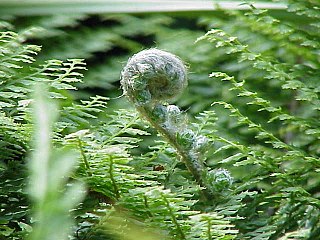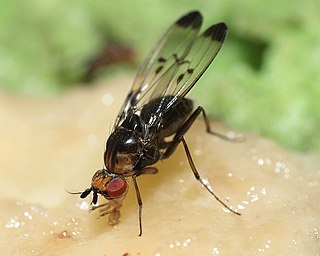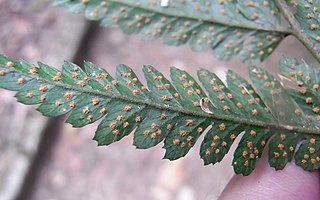
Deua is a national park located in New South Wales, Australia, 320 kilometres (200 mi) south of Sydney, and 100 kilometres (62 mi) east of Canberra. The nearest towns on the coast are Batemans Bay, Moruya and Narooma.
Nathaniel Mountain is a mountain ridge that runs southwest northeast through Hampshire County in West Virginia's Eastern Panhandle, rising to its greatest elevation of 2,739 feet (835 m) above sea-level. The mountain is bound at its western flank by the South Branch Potomac River and to its eastern flank by South Branch Mountain 3,028 feet (923 m). The bulk of Nathaniel Mountain is located within the Nathaniel Mountain Wildlife Management Area (WMA) owned by the West Virginia Division of Natural Resources.

Polystichum is a genus of ferns in the family Dryopteridaceae, subfamily Dryopteridoideae, according to the Pteridophyte Phylogeny Group classification of 2016. The genus has about 500 species and has a cosmopolitan distribution. The highest diversity is in eastern Asia, with about 208 species in China alone; the region from Mexico to Brazil has at least 100 additional species; Africa, North America, and Europe have much lower diversity. Polystichum species are terrestrial or rock-dwelling ferns of warm-temperate and montane-tropical regions. They are often found in disturbed habitats such as road cuts, talus slopes, and stream banks.

Polystichum aculeatum, the hard shield-fern, is an evergreen fern native to Europe. It is most abundant in upland regions of the British Isles and western France, where it benefits from the combination of mild winters and moist summers, but also occurs more locally across most of Europe except northern Scandinavia, northern Russia; in the Mediterranean region it is confined to high altitudes. It grows on steep slopes in woodlands. it is sometimes considered an indicator of the presence of ancient woodlands.

Bartholomew's Cobble is a 329-acre (1.33 km2) National Natural Landmark, open space preserve, agricultural preserve, and bio-reserve located in southwest Massachusetts in the village of Ashley Falls abutting Canaan, Connecticut. The preserve contains more than 800 plant species, including North America's greatest diversity of ferns and the greatest overall biodiversity in Berkshire County, Massachusetts; it also contains Massachusetts' highest populations of ground nesting bobolinks. It was declared a National Natural Landmark in October 1971.

Dryopteris arguta, with the common name coastal woodfern, is a species of wood fern. It is native to the west coast and western interior mountain ranges of North America, from British Columbia, throughout California, and into Arizona.
Lastreopsis subrecedens is a species of fern in the family Dryopteridaceae. It is endemic to China. Its natural habitat is subtropical or tropical moist lowland forests. It is threatened by habitat loss.

Lastreopsis, known as shieldfern, is a genus of ferns in the family Dryopteridaceae, subfamily Elaphoglossoideae, in the Pteridophyte Phylogeny Group classification of 2016.

Lastreopsis decomposita, known as the trim shield fern, is a common plant found in eastern Australia. The habitat is rainforest or moist sheltered eucalyptus forests. It may form large colonies. This fern features delicate lacy fronds, up to 90 cm long. The segments are alternate on the stem, hairy and thin textured.

Adiantum viridimontanum, commonly known as Green Mountain maidenhair fern, is a rare fern found only in outcrops of serpentine rock in New England and Eastern Canada. The leaf blade is cut into finger-like segments, themselves once-divided, which are borne on the outer side of a curved, dark, glossy rachis. These finger-like segments are not individual leaves, but parts of a single compound leaf. The "fingers" may be drooping or erect, depending on whether the individual fern grows in shade or sunlight. Spores are borne under false indusia at the edge of the subdivisions of the leaf, a characteristic unique to the genus Adiantum.

Parapolystichum microsorum, synonym Lastreopsis microsora, known as the creeping shield fern is a common small plant found in eastern Australia and New Zealand. The habitat is rainforest or moist sheltered eucalyptus forests. It may form large colonies. The specific epithet microsora translates to "small sori".

Lastreopsis nephrodioides is a fern in the family Dryopteridaceae. The specific epithet refers to its resemblance to Nephrodium decompositum R.Br..

Central Mountain is a mountain in Columbia County, Sullivan County, and Luzerne County, in Pennsylvania, United States. Its elevation is 2,247 feet (685 m) above sea level. The mountain is part of the Allegheny Front. Rock formations on the mountain include the Pocono Formation and the Duncannon Member of the Catskill Formation. It was historically known as North Mountain, but it was renamed Central Mountain in the late 1800s. The mountain is one of the most important sites on the Columbia County Natural Areas Inventory and it is inhabited by dozens of trees, shrubs, and herbaceous plants. Numerous birds and several amphibians and mammals are also found in the area.
Shield fern is a common name for ferns in several genera and may refer to:

Drosophila silvestris is a large species of fly in the family Drosophilidae that are primarily black with yellow spots. As a rare species of fruit fly endemic to Hawaii, the fly often experiences reproductive isolation. Despite barriers in nature, D. silvestris is able to breed with D. heteroneura to create hybrid flies in the laboratory.

Lastreopsis marginans, known as the glossy or bordered shield fern is a fern found in eastern Australia. The habitat is rainforest or wet sclerophyll forest. Fronds are crowded and erect, between 50 and 90 cm long, coloured a glossy dark green. The lectotype was collected near the Clarence River by Hermann Beckler.

Parapolystichum acuminatum, synonym Lastreopsis acuminata, is a small plant found in eastern Australia. Common names include creeping shield fern, glossy shield fern and shiny shield fern. It is a widespread fern, often seen in wet eucalyptus forest or rainforest, usually near streams.

Lastreopsis hispida, known as the bristly shield fern, is a common plant found in New Zealand. Less often seen in Australia, in cool rainforest areas with humus rich soils, or more rarely as an epiphyte on tree ferns or mossy logs. Listed as endangered in the state of New South Wales where it grows in a few remote sites in the Blue Mountains, such as at Mount Wilson. The specific epithet hispida is from Latin, meaning "bristly".

Parapolystichum munitum, synonym Lastreopsis munita, the naked shield fern is a plant found in tropical and subtropical forest areas in eastern Australia. Often seen in large colonies, near streams in rainforest and wet eucalyptus areas, north from the Barrington Tops.















